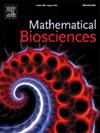大流行急性期后疾病传播的复发模式:来自疾病传播微分方程和行为适应延迟代数方程耦合系统的见解
IF 1.8
4区 数学
Q2 BIOLOGY
引用次数: 0
摘要
我们引入了一个疾病传播微分方程和行为适应代数更新方程的耦合系统来理解大流行急性期后非线性振荡的机制。这扩展了Zhang-Scarabel-Murty-Wu模型,该模型是为了描述COVID-19大流行急性期早期观察到的多波模式而制定和分析的。我们的扩展涉及由于感染而导致易感人群的减少,并包含一个非线性疾病传播项,以反映受感染人群在大流行急性期过后的恢复和暂时免疫。我们当前研究的目标是检查易感人群的减少是否以及如何影响相互交织的疾病传播动态和行为适应。我们引入了一些典型的风险厌恶函数来描述对感知风险的行为反应,并展示了风险厌恶行为和行为适应实施中的逻辑延迟如何共同促成一个由周期振荡波描述的动态平衡状态。我们还将两个连续高峰之间的时间与基本流行病参数、社区对行为变化的灵活性以及人口对感知风险的容忍度联系起来。本文章由计算机程序翻译,如有差异,请以英文原文为准。
Recurrent patterns of disease spread post the acute phase of a pandemic: Insights from a coupled system of a differential equation for disease transmission and a delayed algebraic equation for behavioral adaptation
We introduce a coupled system of a disease transmission differential equation and a behavioral adaptation algebraic renewal equation to understand the mechanisms of nonlinear oscillations post-acute phase of a pandemic. This extends the Zhang–Scarabel–Murty–Wu model, which was formulated and analyzed to describe multi-wave patterns observed at the early stage during the acute phase of the COVID-19 pandemic. Our extension involves the depletion of susceptible population due to infection and contains a nonlinear disease transmission term to reflect the recovery and temporal immunity in the infected population past the acute phase of the pandemic. Examining whether and how incorporating this depletion of susceptible population impacts interwoven disease transmission dynamics and behavioral adaptation is the objective of our current research. We introduce some prototypical risk aversion functions to characterize behavioral responses to perceived risks and show how the risk aversion behaviors and the logistic delay in implementation of behavioral adaptation combined contribute to a dynamic equilibrium state described by a periodic oscillatory wave. We also link the period between two consecutive peaks to basic epidemic parameters, the community flexibility to behavioral change, and the population’s tolerance to perceived risks.
求助全文
通过发布文献求助,成功后即可免费获取论文全文。
去求助
来源期刊

Mathematical Biosciences
生物-生物学
CiteScore
7.50
自引率
2.30%
发文量
67
审稿时长
18 days
期刊介绍:
Mathematical Biosciences publishes work providing new concepts or new understanding of biological systems using mathematical models, or methodological articles likely to find application to multiple biological systems. Papers are expected to present a major research finding of broad significance for the biological sciences, or mathematical biology. Mathematical Biosciences welcomes original research articles, letters, reviews and perspectives.
 求助内容:
求助内容: 应助结果提醒方式:
应助结果提醒方式:


